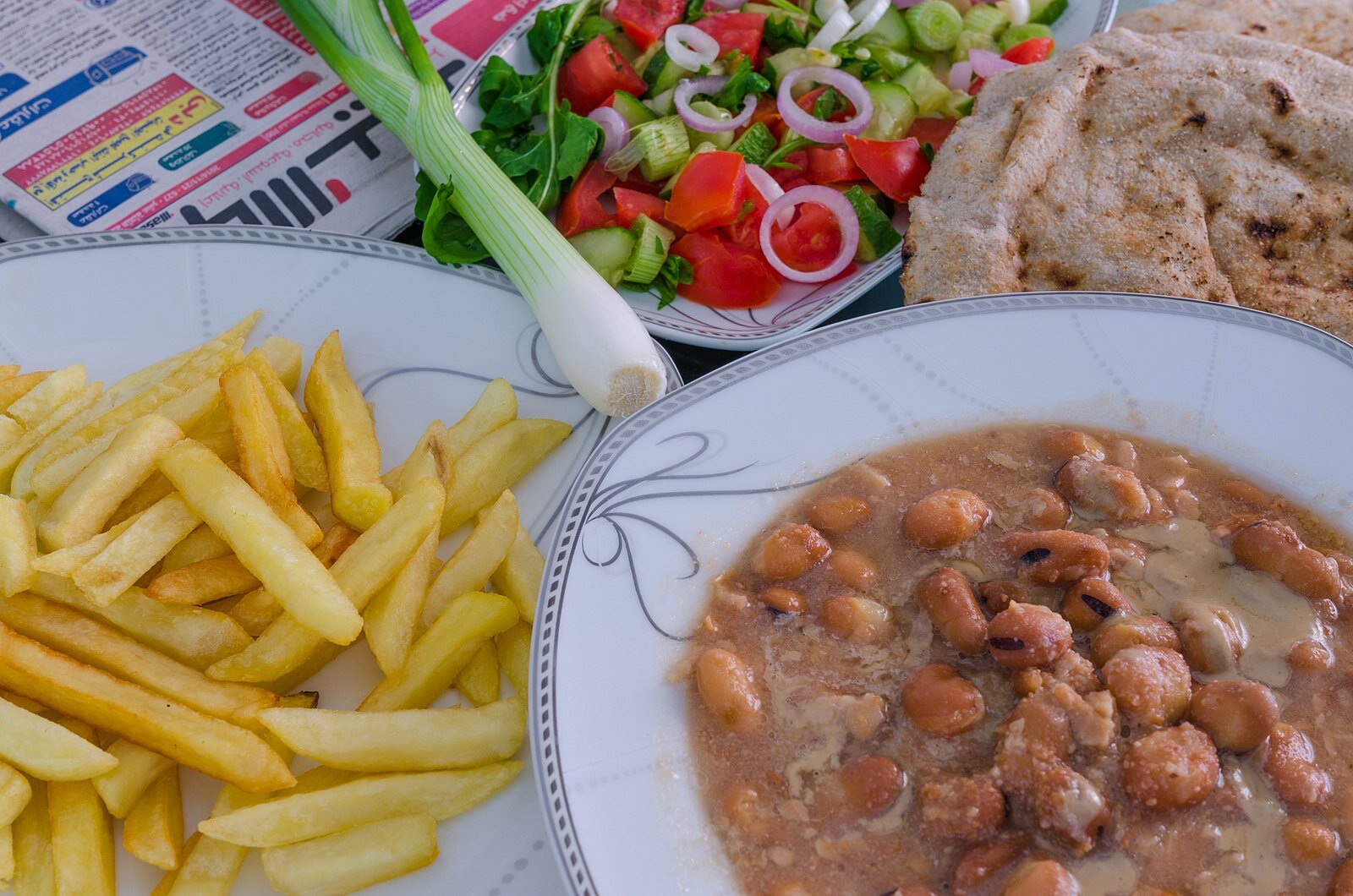9 Foods to Try in Egypt
Almost every Egyptian dish will be accompanied by an entourage of salads and enough bread to feed you for days.
Egypt isn’t exactly known for its food.
Think of the last time you saw an “Egyptian” restaurant in the United States. Wait, you probably have never seen one. Sure, there are lots of Middle Eastern restaurants, but these usually serve a conglomeration of Turkish, Morroccan, Israeli, Syrian, and Lebanese food. The most famous Egyptian dishes that I have eaten time and again in the land of the pharaohs have never made it to the menu of almost all “Middle Eastern” restaurants in the U.S. Despite this, Egypt has a lot of culinary offerings that are both delicious and unique.
So, this gives us a great excuse to travel to Egypt! The only way to experience authentic Egyptian cuisine is to try it in its birthplace. Let us share nine mouth-watering Egyptian delicacies that you must try while you explore the most amazing country in the world.
Disclaimer: This is not an exhaustive list of all foods one should try in Egypt, and it is a list of food dishes only, so we do not include drinks, desserts, or specific fruits/vegetables one must try when on their Egypt adventure. Look for those on a future post!
Koshary
Koshary is the go-to everyone talks about when foreigners come to Egypt. It’s considered a national dish, and it is carb-laden, filling, cheap, available everywhere, and, most importantly, tasty!
What is it: Koshary is a mixture of lentils, macaroni noodles, spaghetti noodles, chickpeas, fried onions, rice, spices, tomato sauce, and as much hot sauce as you can handle.
Where to find it: There is a koshary restaurant in every neighborhood in Cairo, and often you will see street carts selling koshary as well. A famous place to go is Koshary el Tahrir right in downtown Cairo.
😋😋😋
Bamiya
My personal favorite, Bamiya may remind some southern U.S. Americans of good home-cookin’. This is not necessarily a popular Egyptian dish among foreigners, and it is not one of the more famous ones, but I am such a sucker for okra that I have to put it toward the top of the list.
What is it: Sauteed onions and garlic get added to tomato sauce and okra. The whole concoction is simmered for hours, giving it a delicious flavor, and a wonderful texture to the okra (slimy okra, who’s that?).
Where to find it: Bamiya is best when it is homemade, but Abo el Sid in Zamalek (check out our YouTube video on Abo el Sid here) has a great Bamiya bil Lahma (okra with beef) dish.
Homemade Egyptian food is the best way to experience bamiya. Bamiya bil lahma (okra with meat) is at the upper right hand corner of this photo, and mashii kmade with green peppers, zucchini, and mini eggplants are in the left and middle of the frame.
Mashii
Mahshii is comfort food bliss, and there are countless times I have gorged myself on homemade mahshii when paying an Egyptian friend a visit.
What is it: Mahshii is the Arabic word that means “stuffed”, and in the food sense, that’s exactly what it is. Egyptians take hollowed out zucchini, eggplant, bell peppers, or use empty cabbage or grape leaves, and then stuff them to the brink with a spiced rice mixture. The bulging vegetable is then baked until it practically melts in your mouth. The gift of carbs and veggies.
Where to find it: Similar to bamiya, mahshii is best enjoyed homemade. I have yet to find a good restaurant that does mahshii justice. The search continues!
😋😋😋
Hammam
When I first came to Egypt and heard that one of the foods I needed to try was grilled pigeon, I nearly lost it. “These people eat pigeons?!” I remember thinking. Lo and behold, once I tried my first grilled pigeon, I became a believer, and wondered why we never grilled up pigeons in Minnesota where I grew up!
Hammam (pigeon) stuffed with rice, and extra rice on the side. There can never be too much rice in Egypt.
What is it: Hammam means pigeon in Arabic, and that’s what it is. A pigeon, grilled, and sometimes stuffed with rice, too.
Where to find it: The ultimate authority on grilled pigeons is Farahat, a restaurant in the Islamic center of Old Cairo, by Al Azhar Mosque.
😋😋😋
Kebda
Don’t go running for the hills when we tell you what’s in kebda! The Egyptians really know how to prepare this food in a way that will make you not care what it’s made of, only how delicious it tastes!
Hyperventilating because I am about to chow down on a plate full of kebda, some fresh French bread, and spicy peppers.
What is it: Kebda is the Arabic word for liver, and that’s a pretty straightforward description of what the dish is--grilled/fried/sauteed liver. It is usually served in a french bun as a sandwich, alongside spicy hot peppers.
Where to find it: Kebda is everywhere, but the best place to get it is in Alexandria, especially at a restaurant called Kebda Awlad Alflah. Alexandrians make Kebda in a special way, adding in sauteed bell peppers, onions, tomatoes, and some spices that make a good food even more tasty.
😋😋😋
Taamiya
Taamiya is breakfast food from heaven. It is the Egyptian version of falafel, but it actually isn’t technically falafel, because it is made from a different bean. In my opinion, this makes it even better!
Delicious food, two ways: the top shows taamiya in its pure form, all by itself. The bottom shows it in a sandwich, nestled among veggies and tahini sauce in pita bread.
What is it: While falafel’s main ingredient is chickpeas, taamiya is mostly comprised of mashed fava beans. The beans are mixed with onions, parsley, cilantro, other spices, and then fried in vegetable oil. You will often see taamiya served up in a pita bread pocket with a cucumber salad and some tahini sauce thrown in. A sandwich fit for a god.
Where to find it: In any city in Egypt, places to buy taamiya abound. The best time to pick some up is early morning until about 11am, the time most Egyptians finish their breakfast of taamiya before starting the workday.
😋😋😋
Molokheya
I’ll be honest, I don’t eat molokheya anymore unless it is in someone’s home and I want to be polite. It’s just not for me. However, this soup is considered another national dish in Egypt, and Egyptians will insist that all tourists need to try it.
Molokheya is the green soup in each picture. In the bottom picture, it is served with white rice and grilled chicken, a common accompaniment.
What is it: Molokheya is a soup that is made up of a leafy vegetable called Jew’s Mallow (you’ll have to look it up), cooked in a fatty broth, and served up with rice and some sort of protein, usually grilled rabbit or chicken. Molokheya is not eaten by itself, rather, the soup is usually spooned onto a bed or rice and eaten in tandem with the rice and whatever meat is served with it.
Where to find it: Same as mahshii, molokheya is best consumed at someone’s home. However, I have heard that the wonderful restaurant Fasahet Somaya in downtown Cairo will occasionally serve molokheya, in which case it would be of the same quality as having it homemade.
😋😋😋
Fuul
While not my favorite Egyptian food, fuul is so common and such a staple part of the Egyptian diet that no gastronomic tour of Egypt is complete without giving it a try.
Fuul is in the bottom right-hand corner. The beans are ready to be scooped up with some bread and devoured, along with some fries and fresh veggies. Picture from Wikipedia, Creative Commons License
What is it: Fuul is made when fava beans are simmered for many hours (sometimes overnight) with a concoction of spices, until the beans turn into a mushy mess of legume paradise. Fuul is usually served with pita bread that works as a makeshift scoop.
Where to find it: Fuul is like taamiya, in that it is everywhere, and is best to get in the morning. My personal favorite spots to have fuul are fancy hotel buffets, which often feature a fuul bar: you can jazz up the rather plain bean mixture with any number of condiments, spices, lemon juice, and chopped vegetables.
Egyptians line up at a Fuul cart in downtown Cairo for some breakfast. Picture from Wikipedia, Creative Commons License
Hawawshi
One of my foreign friends in Cairo loved hawawshi (pronounced HUH-WOW-SHE) so much that she named her cat hawawshi, and I can see why. Hawawshi is hot, greasy, filling, and to die for.
Hawawshi is serious business. Here’s a still from a video of me explaining what the deliciousness of Hawawshi is, while our server cuts the hawawshi he just brought from the grill.
What is it: Hawawshi is ground beef, chopped up with all sorts of spices and sometimes peppers and onions, and then stuffed into pita bread and pushed onto a skillet with a hot iron weighing it down. The meat has such a high fat content that the bread comes out looking like the outside of a perfect grilled cheese sandwich, with the inside filled with tender, delicious meat.
Where to find it: Hawawshi el Rafaayee, located behind Abdeen Palace in Cairo, has excellent hawawshi and has a lot of varieties to choose from. You can add cheese (or not), get your hawawshi extra spicy, or try to make it healthy by throwing in a ton of vegetables. The sky’s the limit!
😋😋😋
Are you hungry yet?
Sharing the special and delicious food of Egypt is one of the reasons we at Egypt Adventures Travel love taking folks to explore more than just the Pyramids. We are excited to satisfy your bellies when you travel with us. The best part? We get to try the food right alongside you!
What food are you most excited to try? Which one surprised you the most? Do you have any questions about the food or places we shared? Leave us a comment below!
Be on the lookout for a future blog post focused all on desserts and Egyptian sweets-yum!











